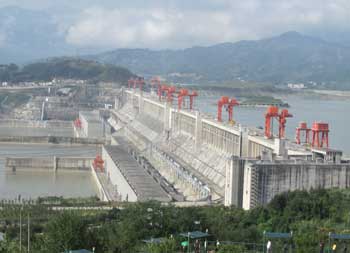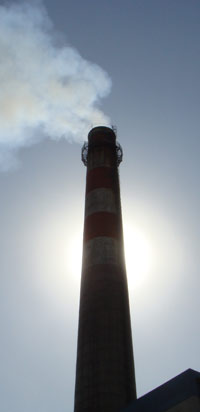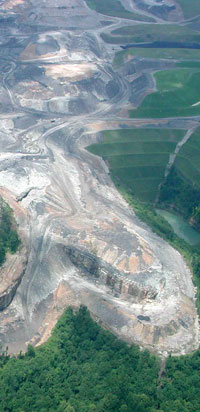
 Chinese leaders are taking stock of the monetary and environmental price tag for China’s phenomenal growth.
Chinese leaders are taking stock of the monetary and environmental price tag for China’s phenomenal growth.
The government recently reported on the country’s grave environmental problems and officially acknowledged downstream harm caused the Three Gorges Dam. Meanwhile a widespread drought, intensified by emptied aquifers and a polluted Yellow River, turned up the volume on talk of a massive water diversion project to move 6 trillion gallons of water annually from south China to parched northern provinces.
There’s been talk of putting quality and sustainability of economic growth ahead of quantity for the better part of a decade. But the rhetoric has not been matched by fundamental policy changes, such as shifting away from infrastructure investment and manufacturing for export and toward services, or subtracting the cost of pollution and environmental destruction from GDP figures. Officials’ promotions are still based upon GDP growth.
Setting it straight: “Officials make the statistics, and the statistics make the officials,” as the Chinese say. In other words, GDP figures are largely the result of official fiat, as upbeat economic statistics are the key to official promotions. Instead of looking at often-deceptive GDP figures, it’s better to look at stats for energy consumption.
I’ll be watching … to see if China pulls back from infrastructure mega-projects, like the south-to-north water diversion project, hydropower dams, or high-speed rail. After the 18th Party Congress in 2012, many of China’s technocrats with Soviet-era engineering backgrounds who have favored mega-projects will step aside to make way for the 5th generation of communist leaders.
Read more about this topic
- Setbacks Stall Finish Of China's Massive Dam Project [By Anthony Kuhn, NPR]
- The Three Gorges Reservoir: A Series Overview [By Anthony Kuhn, NPR]
- Concerns Rise with Water of Three Gorges Dam [By Anthony Kuhn, NPR]
- Going It Alone Downstream to China's Three Gorges [By Anthony Kuhn, NPR]
- Relocated Three Gorges Residents Face Challenges [By Anthony Kuhn, NPR]
- Three Gorges History Drowning in Rising Reservoir [By Anthony Kuhn, NPR]
- When a Billion Chinese Jump [By Jonathan Watts, When a Billion Chinese Jump]
Some experts estimate that China’s rapid development without adequate protections costs it 9 percent of the nation’s GDP and more 400,000 lives a year. China’s Ministry of Environmental Protection just declared that the country faces a “very grave” environmental situation, but they have tried to make the environment a priority for nearly a decade — without much success. The top-down control structure of the Chinese Communist Party isn’t good at finding problems until after they are obvious to everyone. The central government’s inability to control local-level officials was made clear by the environment minister’s statement last Friday that “more than a fifth of the land that has been set aside as nature reserves had been illegally developed by companies, often with local government collusion.”
I’ll be watching … to see whether Beijing will be able to clean up its domestic environmental problems without allowing a greater civil society.
I’m wondering … whether Beijing’s commitment to improve pollution controls will translate into leadership on global environmental problems. China now emits nearly one-quarter of the world’s carbon dioxide, burns nearly half of the coal used globally, and is the top consumer of a wide range of things, from shark fins to tropical logs.
Read more about this topic
The environmental story in China is also a human rights story. In cities like Datong, Lifen, or Taiyuan, day-to-day breathing is deadly because of the air pollution. Behind the Three Gorges Dam, whole cities have been subsumed, and communities above the reservoir line face landslides and increased incidence of disease. Animals have also paid a heavy toll; these dams have destroyed the unique ecosystem of the Yangtze. Case in point is the extinction of the baiji, a freshwater dolphin, though overfishing is also to blame.
Background: Environmental costs for Three Gorges Dam were recognized when it was first proposed in the early 20th century. The Chinese government has merely officially acknowledged what people, including engineers, have been saying for decades. On the other hand, China faces difficult choices in terms of how to generate electricity; the likely suspects now and in the future are hydropower, nuclear, or coal.
The irony is … historically, human health has benefited greatly from an increased access to energy. Yet, as we see in China, energy generation can also become a health risk.
Read more about this topic
- Damming the Yangtze: Are a Few Big Hydropower Projects Better Than a Lot of Small Ones? [By David Biello, Scientific American]
- Back to the Future: Harnessing the Power of the Yangtze River [By David Biello, Scientific American]
- China's Big Push for Renewable Energy [By David Biello, Scientific American]
- China's Three Gorges Dam: An Environmental Catastrophe? [By David Biello, Scientific American]
- Requiem for a Freshwater Dolphin Home » News » Home » News » News | More Science Requiem for a Freshwater Dolphin News | More Science Requiem for a Freshwater Dolphin [By David Biello, Scientific American]
| Tweet This Page |












